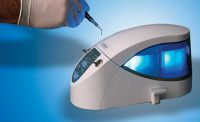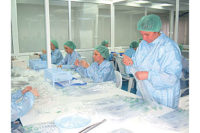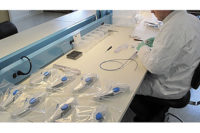With the rise in antibiotic-resistant “superbugs” in hospitals and medical centers, cleanliness and sterilization of medical devices have become a top priority. Cleaning products have become stronger and more aggressive to sanitize devices and prevent the spread of illness between patients.
Ironically, current medical device designs often don’t meet the cleanability requirements of medical facilities. While medical professionals have expressed their concern, there seems to be a disconnect between the makers of products and those who use them.
Richard Fechter, clinical engineer at University of California San Francisco Medical Center, tests thousands of products each year and has noticed that cleanability isn’t always a manufacturer’s highest priority. Fechter spends much of his time developing new tools and devices and reimagining current products to be safer and more functional.
“The physical design of certain products makes them nearly impossible to clean and disinfect,” says Fetcher. “Anything that has seams with wide openings makes removing organic material, especially blood, extremely difficult.”
To be fair, design features for functionality and cleanability can be contradictory. For example, a smooth, glass-like surface is easy to clean but hard to grip. However, adding surface texture for grip can make the device more difficult to completely disinfect.
The materials used in medical device manufacturing must be able to withstand harsh cleaning products. Hospitals battle the latest superbug with stronger cleaners and disinfectants, often switching between products to best maintain cleanliness. Unfortunately, these product standards change at a rate manufacturers are unable to accommodate. Certain plastics may be incompatible with cleaning products causing cracking or warping. Repeated disinfecting can also weaken the product, shortening the lifespan of an expensive device.
So how can manufacturers meet the demands for safer, easier to clean products? There are some alternatives, such as single use disposable products, that offer both functionality and cleanability. However, even these have some disadvantages.
Single-use or disposable products would be the cleanest option. Many single-use products would come sterilized in their own individual packaging. These would be ideal for hard-to-clean devices, such as endoscopes, that are at a high risk of infecting patients. The drawback is that they are expensive and can only be used once. Fechter proposes that if single-use products were more cost effective, they would be the gold standard for medicine.
Other products are too expensive to only be used once, such as devices with cameras or extensive electronics. In certain cases, keyboards and control panels can be replaced with digital touch screens that are more durable and easier to clean. The disadvantage with these would be that users lose the ability to navigate by touch—the feel of buttons or knobs would be replaced with a flat surface which would require more time or attention.
Alternatively, Fechter suggests draping or covers for larger and more difficult-to-replace items. These would act as a sealed barrier between the device and the environment that can be changed after each use. This would protect the housing material from harsh cleaners and maintain a level of sterility. Drapes and covers are also more cost-effective than other options.
Medical device manufacturers have made many advances in making products more durable and easy to clean. These alternatives are promising, yet there are still small issues that could be easily remedied. Simply testing a wider variety of cleaning products on devices would go a long way, according to Fechter.
“The design shouldn’t require the users to adapt to or work around issues,” says Fechter. “Patient safety and cleanability should be a high priority.”



